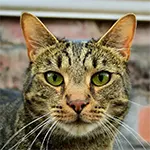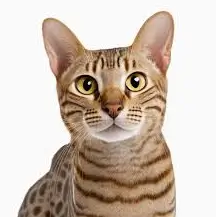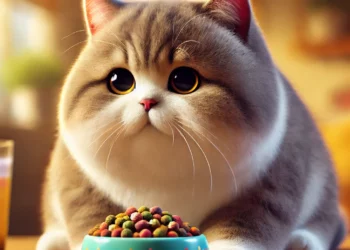
The exotic ocicat attracts people immediately and forever. Its name derives from the ocelot, a wild cat, because the mottling of its fur is similar to this. However, the character of the ocicat is not that wild, in fact, it is quite cuddly and faithful, making it a popular domestic cat.
Summary
The Ocicat is a remarkable cat breed known for its wild appearance that resembles a small leopard, yet it is entirely domesticated with a friendly and outgoing personality. Despite its exotic spots, the Ocicat has no wild DNA in its lineage, making it an excellent choice for those who admire the look of wild cats but prefer the temperament of a domestic feline. This guide will provide you with everything you need to know about the Ocicat, from its history and physical traits to its care needs and personality, making it a valuable resource for current and prospective Ocicat owners.
History of the Ocicat
Origins and Development
The Ocicat breed was developed in the United States in the 1960s, and its creation was purely accidental. A breeder named Virginia Daly was attempting to produce a Siamese cat with Abyssinian points by crossing a Siamese with an Abyssinian. The resulting kittens carried the genes of both breeds, but one of the litters produced a unique, spotted kitten that resembled a wild ocelot. This kitten, named Tonga, became the first Ocicat.
Enthused by Tonga’s striking appearance, breeders began to intentionally develop the breed by crossing Siamese, Abyssinians, and American Shorthairs. The goal was to create a cat with the wild appearance of an ocelot but with the temperament of a domestic cat. The breed was officially recognized by the Cat Fanciers’ Association (CFA) in 1987 and has since gained popularity for its beauty and personality.
Physical Characteristics
Appearance and Size
Ocicats are medium to large-sized cats, with males typically weighing between 10 to 15 pounds and females slightly smaller. They have a strong, muscular build, which contributes to their athletic and agile appearance. Their bodies are well-proportioned, with long legs, a slightly curved back, and a distinctive tail that is thick at the base and tapers to a pointed tip.
The most striking feature of the Ocicat is its coat. The coat is short, smooth, and close-lying, with a satin-like texture that is easy to care for. The coat pattern is spotted, with dark, thumbprint-shaped spots evenly distributed across the body. These spots give the Ocicat its wild, exotic look. The breed comes in a variety of colors, including tawny, chocolate, cinnamon, blue, lavender, and fawn, often with a silver base, which further enhances the contrast and visibility of the spots.
Eyes and Expression
Ocicats have large, almond-shaped eyes that can be any color except blue. The eyes are set at a slight angle, giving the cat a keen and alert expression that complements its wild appearance. Their ears are moderately large, with a slight forward tilt, and some Ocicats may have tufts of fur on the tips, adding to their exotic look.
Personality and Temperament
Affectionate and Social
Despite their wild appearance, Ocicats are known for their affectionate and friendly nature. They form strong bonds with their human families and enjoy being involved in daily activities. Ocicats are often described as “people-oriented” cats, as they thrive on human interaction and are happiest when they are around their loved ones. They are also known to be loyal companions, following their owners from room to room and even greeting them at the door when they come home.
Playful and Intelligent
Ocicats are highly intelligent and curious cats. They are quick learners and can be trained to perform tricks, fetch toys, and even walk on a leash. Their playful nature makes them great companions for active households, and they often enjoy interactive toys and puzzle feeders that challenge their minds. Ocicats are also known for their high energy levels, so they require plenty of playtime and mental stimulation to keep them happy and healthy.
Social and Adaptable
Ocicats are social cats that generally get along well with other pets, including dogs and other cats. They are adaptable and can thrive in various living environments, whether it’s a busy family home or a quieter single-person household. Their outgoing and confident nature makes them well-suited to living with children and other pets, provided they are introduced properly and given time to adjust.
Grooming and Maintenance
Coat Care
One of the benefits of owning an Ocicat is its low-maintenance coat. The short, sleek fur requires minimal grooming, with a weekly brushing usually sufficient to keep it in good condition. Brushing helps to remove loose hairs and distribute natural oils throughout the coat, keeping it shiny and healthy. The Ocicat is not prone to excessive shedding, making it a good choice for people who prefer a cat that doesn’t require a lot of grooming.
Dental and Nail Care
Like all cats, Ocicats benefit from regular dental care. Brushing their teeth several times a week with a cat-specific toothpaste can help prevent dental diseases such as tartar buildup and gingivitis. Their nails should also be trimmed every few weeks to prevent overgrowth and to keep them from becoming too sharp. Providing scratching posts around your home can help them maintain healthy nails naturally.
Ear and Eye Care
Ocicats are generally healthy cats, but it’s important to check their ears regularly for signs of dirt or infection. Cleaning their ears with a vet-recommended ear cleaner as needed can help prevent infections. Their eyes should also be checked regularly and wiped clean with a damp cloth if there is any discharge.
Diet and Nutrition
Nutritional Requirements
Ocicats are active and muscular cats, so their diet should be rich in high-quality protein to support their energy levels and maintain their muscle mass. Both wet and dry cat food can be part of their diet, but it’s important to choose products that are specifically formulated for their life stage—kitten, adult, or senior. Some Ocicats may benefit from a diet that includes a mix of both wet and dry food, which can help ensure they stay hydrated and receive the necessary nutrients.
Portion Control
Due to their active nature, Ocicats have a healthy appetite, so it’s important to monitor their food intake to prevent overeating. Providing measured portions based on their age, weight, and activity level is the best way to manage their diet. Avoid free-feeding and instead offer meals at specific times each day. Regularly monitoring your cat’s weight and adjusting their diet as needed can help prevent obesity and related health issues.
Hydration
Ensuring that your Ocicat stays well-hydrated is crucial. Providing fresh water at all times is essential, and some cats may prefer running water from a cat fountain. Wet food can also contribute to their overall hydration, which is important for maintaining healthy kidneys and urinary function.
Health and Lifespan
Common Health Issues
Ocicats are generally healthy cats, but like all breeds, they can be prone to certain health issues. Some of the common conditions seen in Ocicats include:
- Hypertrophic Cardiomyopathy (HCM): This is a common heart condition in cats, including Ocicats, where the heart muscle becomes abnormally thickened. Regular veterinary check-ups and echocardiograms can help detect HCM early.
- Renal or Liver Amyloidosis: This is a condition where proteins called amyloids build up in the organs, leading to organ dysfunction. Regular health screenings and monitoring can help manage this condition.
- Periodontal Disease: Like many cats, Ocicats can be prone to dental issues, so regular dental care is essential to prevent tartar buildup and gum disease.
Lifespan
With proper care, Ocicats typically live between 12 to 18 years, although some can live even longer. Ensuring they have a balanced diet, regular exercise, and routine veterinary care can help them lead a long, healthy life.
Tips for Living with an Ocicat
Provide Plenty of Stimulation
Ocicats are active and intelligent cats that require plenty of mental and physical stimulation to stay happy. Providing a variety of toys, interactive play sessions, and puzzle feeders can help keep them engaged. They also enjoy climbing and exploring, so cat trees, shelves, and window perches can provide the enrichment they need.
Social Interaction
Ocicats are social cats that thrive on interaction with their human families. Make sure to spend quality time with your Ocicat, whether it’s through play, grooming, or simply keeping them company. They don’t like being left alone for long periods, so if your household is often empty, consider getting another pet to keep them company.
Regular Veterinary Care
Due to their susceptibility to certain health issues, regular veterinary check-ups are essential for Ocicats. Annual or bi-annual visits will help monitor their health and detect any issues early, ensuring they remain healthy and happy.
FAQs about Ocicat Cats
Are Ocicats good with children?
Yes, Ocicats are known for their friendly and patient nature, making them excellent companions for families with children. They are playful and enjoy interacting with kids, making them well-suited to an active household.
How much grooming do Ocicats require?
Ocicats have a short, low-maintenance coat that requires minimal grooming. Weekly brushing is usually sufficient to keep their coat healthy and shiny, making them a great choice for those who prefer a cat with low grooming needs.
Do Ocicats get along with other pets?
Yes, Ocicats are social cats that generally get along well with other pets, including dogs and other cats. Their outgoing and adaptable nature makes them a good fit for multi-pet households.
What health issues are common in Ocicats?
Ocicats are generally healthy but can be prone to certain conditions such as Hypertrophic Cardiomyopathy (HCM), Renal or Liver Amyloidosis, and periodontal disease. Regular veterinary check-ups and a good care routine can help manage these risks.
How long do Ocicats live?
With proper care, Ocicats typically live between 12 to 18 years, although some may live longer. Regular exercise, a balanced diet, and routine health checks are key to ensuring a long, healthy life for your Ocicat.
Latest on CatOlympus
Effects Of Music On Cats: Do Cats Enjoy Music?
For many cat owners, music is a regular part of daily life. We play it while cooking, cleaning, relaxing, or...
Myths And Truths About Feeding Your Cat
Feeding your cat is more than just picking up the nearest bag of kibble. It’s about providing balanced nutrition to...
How To Ensure Your Cat Drinks Enough Water
Water is essential for life, and just like humans, cats need adequate hydration to maintain their health and well-being. However,...
How to Spot and Prevent Parasites In Cats
Parasites are an unfortunate but common issue that many cat owners will face at some point. These unwelcome visitors can...










